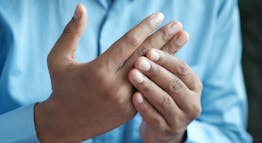The Shoulder Joint
Explore Innerbody's 3D anatomical model of the shoulder joint, the most flexible joint in the entire human body.

The most flexible joint in the entire human body, our shoulder joint is formed by the union of the humerus, the scapula (or shoulder blade), and the clavicle (or collarbone). Commonly thought of as a single joint, the shoulder is actually made up of two separate joints - the glenohumeral and acromioclavicular joints. These two joints work together to allow the arm both to circumduct in a large circle and to rotate around its axis at the shoulder.
The glenohumeral joint is a ball-and-socket joint formed between the articulation of the rounded head of the humerus (the upper arm bone) and the cup-like depression of the scapula, called the glenoid fossa. The glenoid fossa forms a very shallow socket, so the muscles, ligaments, and cartilage of the shoulder joint reinforce its structure and help to prevent dislocations. A ring of cartilage known as the labrum surrounds the glenoid fossa to extend the size of the socket while maintaining flexibility. To further reinforce the shoulder, the four muscles of the rotator cuff extend from the scapula and surround the head of the humerus to both rotate the arm and prevent dislocation.
The acromioclavicular joint is formed by an articulation between the lateral end of the clavicle and the acromion process of the scapula. It is a flat, gliding joint that gives the shoulder joint additional flexibility that would not be possible with just the glenohumeral joint.
Although both of these joints are held together by extensive ligament and muscle attachments, certain types of force can easily weaken the shoulder. The shoulder joint is vulnerable to dislocations from sudden jerks of the arm, especially in children before strong muscles have developed. Dislocation of the shoulder is extremely painful and may require surgical repair or even cause permanent damage.
Chronic or acute wear and tear on the glenohumeral joint can lead to the painful tearing of the tendons of the rotator cuff or a torn labrum. Both of these conditions are very painful and may require surgery to remove or reattach the torn tissue.









